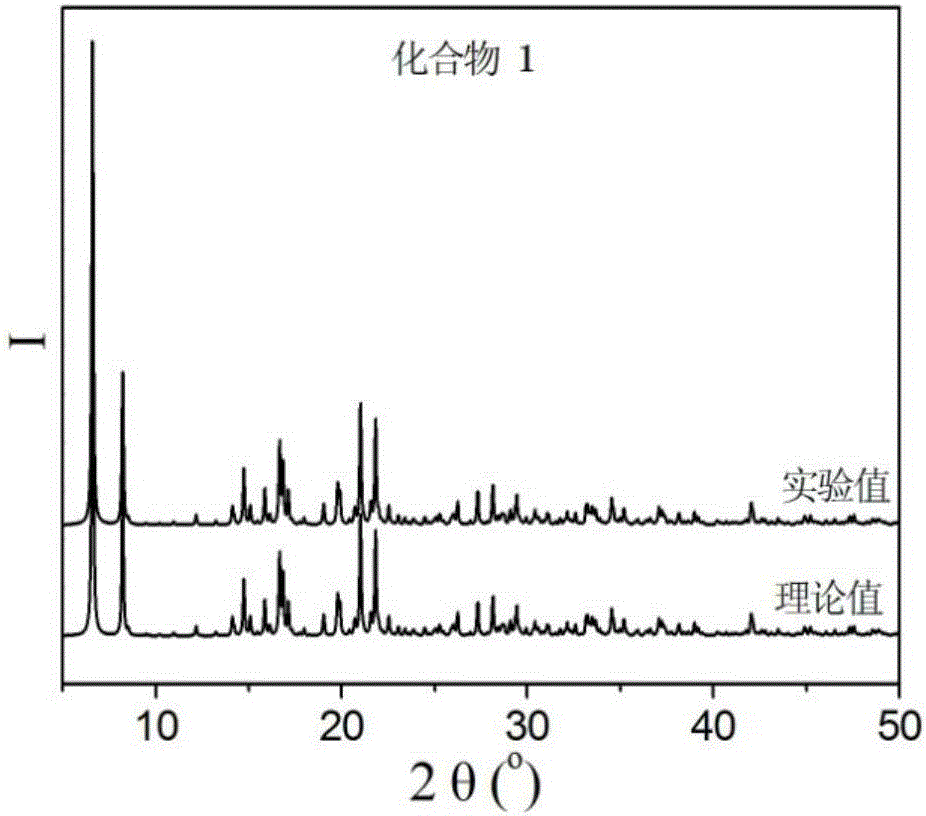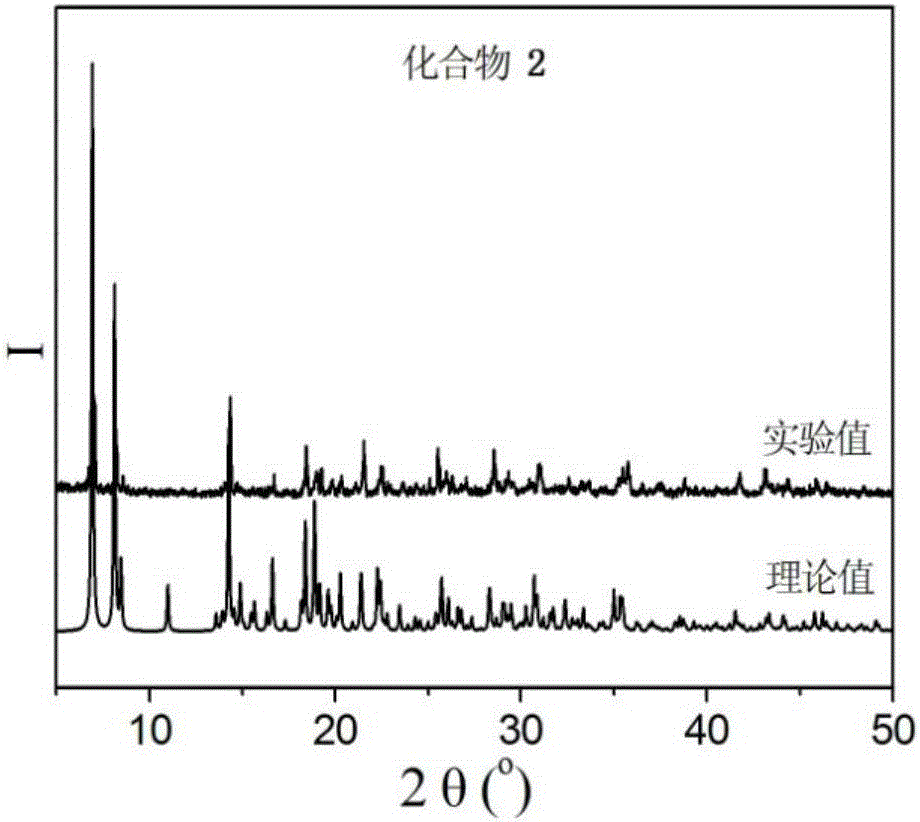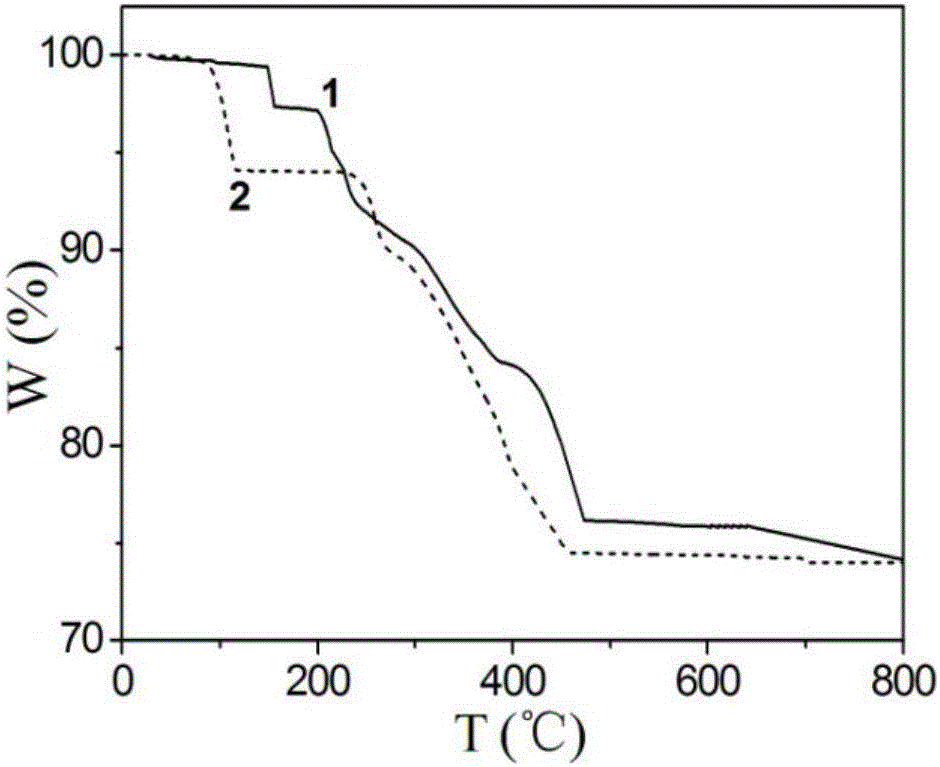Treatment method of organic contaminants of methylene blue and congo red
An organic pollutant, methylene blue technology, applied in the fields of adsorption materials and photocatalytic materials, can solve problems such as poor stability, and achieve the effects of high synthesis yield, reduced energy consumption, and shortened crystallization process.
- Summary
- Abstract
- Description
- Claims
- Application Information
AI Technical Summary
Problems solved by technology
Method used
Image
Examples
Embodiment 1
[0046] 1.1. Preparation of organic dye treatment agent (photocatalyst or adsorbent)
[0047] 0.4mmol CuCl 2 2H 2 O, 0.10mmol N,N'-bis(4-pyridinecarbonyl)-1,2-ethane, 0.15mmol Na 3 [CrMo 6 h 6 o 24 ]·8H 2 O and 8.0 mL H 2 O was sequentially added to a 25mL beaker, and stirred at room temperature for 30min to obtain a suspension mixture. After the pH of the suspension mixture was adjusted to 2.3 with 1.0mol / L HCl solution, it was transferred to a 25mL autoclave and heated at 2.5°C / h. The heating rate was increased to 110°C, and the temperature was kept for 80 hours under hydrothermal conditions. The temperature was lowered to room temperature at a cooling rate of 2.5°C / h, and a small amount of blue block crystals and the main product blue strip crystals were obtained. Alternately washed with water and ethanol for 3 times, and dried naturally at room temperature, the complex Cu 5 (μ 2 -OH) 2 (4-dpye) 2 [CrMo 6 (OH) 5 o 19 ] 2 (H 2 O) 4 (yield is 5%) and {Cu(4-Hdp...
Embodiment 2
[0051] 1.1. Preparation of organic dye treatment agent (photocatalyst or adsorbent)
[0052] 0.6mmol CuCl 2 2H 2 O, 0.10mmol N,N'-bis(4-pyridinecarbonyl)-1,2-ethane, 0.3mmolNa 3 [CrMo 6 h 6 o 24 ]·8H 2 O and 10.0 mL H 2 O was sequentially added to a 25mL beaker, and stirred at room temperature for 30min to obtain a suspension mixture. After the pH of the suspension mixture was adjusted to 2.8 with 1.0mol / L HCl solution, it was transferred to a 25mL autoclave. The heating rate was raised to 130°C, and the temperature was kept for 100 hours under hydrothermal conditions, and the temperature was lowered to room temperature at a cooling rate of 2.5°C / h to obtain a small amount of blue blocky crystals and the main product blue stripy crystals. Alternately washed with water and ethanol for 3 times, and dried naturally at room temperature, the complex Cu 5 (μ 2 -OH) 2 (4-dpye) 2 [CrMo 6 (OH) 5 o 19 ] 2 (H 2 O) 4 (yield is 9%) and {Cu(4-Hdpye)[CrMo 6 (OH) 6 o 18 ](...
Embodiment 3
[0056] 1.1. Preparation of organic dye treatment agent (photocatalyst or adsorbent)
[0057] 0.5mmol CuCl 2 2H 2 O, 0.10mmol N,N'-bis(4-pyridinecarbonyl)-1,2-ethane, 0.25mmol Na 3 [CrMo 6 h 6 o 24 ]·8H 2 O and 10.0 mL H 2O was sequentially added into a 25mL beaker, and stirred at room temperature for 30min to obtain a suspension mixture. After the pH of the suspension mixture was adjusted to 2.5 with 1.0mol / L HCl solution, it was transferred to a 25mL autoclave. The heating rate was increased to 120°C, and the temperature was kept for 96 hours under hydrothermal conditions. The temperature was lowered to room temperature at a cooling rate of 2.5°C / h, and a small amount of blue block crystals and the main product blue strip crystals were obtained. Alternately washed with water and ethanol for 3 times, and dried naturally at room temperature, the complex Cu 5 (μ 2 -OH) 2 (4-dpye) 2 [CrMo 6 (OH) 5 o 19 ] 2 (H 2 O) 4 (yield is 13%) and {Cu(4-Hdpye)[CrMo 6 (OH) 6...
PUM
 Login to View More
Login to View More Abstract
Description
Claims
Application Information
 Login to View More
Login to View More - R&D
- Intellectual Property
- Life Sciences
- Materials
- Tech Scout
- Unparalleled Data Quality
- Higher Quality Content
- 60% Fewer Hallucinations
Browse by: Latest US Patents, China's latest patents, Technical Efficacy Thesaurus, Application Domain, Technology Topic, Popular Technical Reports.
© 2025 PatSnap. All rights reserved.Legal|Privacy policy|Modern Slavery Act Transparency Statement|Sitemap|About US| Contact US: help@patsnap.com



